Angus Advisor
March herd management tips from cattle experts across the nation.
Mid-South Atlantic Region
The genetic landscape of beef production has changed significantly and rapidly in recent years. New technologies have emerged to improve the prediction of an animal’s genetic merit early in life, and new traits and selection indexes have been developed to assist in selection for a variety of traits. Technology continues to advance at a rapid pace, and the tools available to breeders have never been greater.
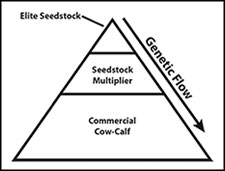
Utilizing these tools, breeders have affected a significant amount of genetic change in a relatively short amount of time, but there is a distinct difference between genetic change and genetic progress. Genetic progress is the goal, and genetic change can be a means to achieve the goal; however, genetic progress implies movement toward the overall goal — optimum profit potential. The overall goal may require genetic change; it may not. It may be an increase in uniformity (homozygosity) or maintenance of an optimum. Unfortunately, it appears that selection in the industry is driven toward continual and rapid genetic change in easy-to-measure traits.
Consider the hierarchy of genetic flow illustrated in the figure accompanying this article. At the top of the genetic chain is the elite seedstock producer, or the true seedstock breeder. Elite breeders have defined goals, but are forward-thinking. They do not waiver with industry trends or fads. They challenge their cattle environmentally. They select for optimums, not maximums. They often utilize linebreeding as a tool to increase homozygosity, fix positive traits and, most importantly, identify and eliminate problem genes.
Elite seedstock breeders define where the industry will go genetically.
Secondly, seedstock multipliers utilize genetics from elite breeders and reproduce those genetics in volume for the commercial producer. Multipliers are not the genetic engineers of the industry; they are the genetic distributors.
At either level, seedstock producers are tasked with creating and providing access to genetics that will move the industry forward as a whole. This is a tremendous responsibility and one that should not be taken lightly. Effectually, the future of many is in the hands of a few, including genetic services companies.
If we consider the selection decisions currently being made at these higher levels of the genetic hierarchy, are true considerations for profit at the bottom of the pyramid driving those decisions? Are they creating genetics to maintain a balance between biologically efficient, cost-effective maternal value and terminal traits (i.e., bulls to create females in a crossbreeding system)? Are maternal-breed bulls being selected for fertility, soundness and longevity first? Then growth and carcass value? Are these options available as AI sires?
Although your answers to the above questions will likely depend upon perspective, I have found it difficult to find an AI sire that will satisfy my preferences. In fact, I have found it difficult to find real differences between the offerings of varying companies. From my perspective, it seems this segment of our industry has become confined by a lack of genetic diversity and an unwillingness to select what is necessary for the improvement of the industry rather than what will generate the greatest revenue.
Because the two should be the same, I am left wondering why they are not. I believe it is because our industry remains focused on outputs rather than inputs. Remember, outputs determine revenue. Inputs determine profit.
[Click here to go to the top of the page.]
Southern Great Plains
The ruminant animal
Ruminants serve an important role in the food production chain. They are also efficient recyclers. Most people are aware that ruminant animals thrive consuming forages that grow in pastures and rangeland not suitable for crop production. However, many may not be aware that ruminants have the ability to utilize a wide variety of food and feed products that are not used by humans or monogastric animals. Restaurant grease, leftover grocery produce, water-damaged candy, byproduct feeds produced by the ethanol industry, stale bread and outdated potato chips are a few examples.
In fact, this incredibly adaptable digestive system utilizes billions of microorganisms to harvest energy, protein and other nutrients from feed and forages before returning it to the landscape as a valuable fertilizer resource. In doing so, forage, feed and otherwise wasted human food products are converted into nutritious products like meat and milk. The following article provides an overview of the components of the ruminant digestive system and the amazing process of fermentation and nutrient absorption.
Stomach compartments
A ruminant animal has four stomach compartments: the reticulum, the rumen, the omasum, and the abomasum (see Fig. 1).
The reticulum is a smaller fermentation compartment in front of the rumen. The reticulum is distinguished by its honeycomb epithelial (lining) structure (see Fig. 2) and is primarily responsible for assisting in rumination contractions and distributing feed within the rumen system. The reticulum can contain up to 2½ gallons of feed being digested.
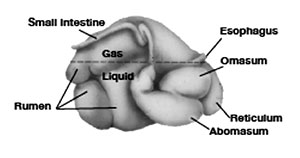
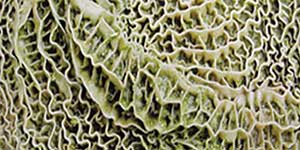
The rumen develops anatomically in size, structure and microbial activity as the calf’s diet is changed from milk to forage. Strong contractions result in maximum exposure of microbes to ingested feeds. Consequently, feeds are subjected to microbial fermentation in the rumen before being passed into the small intestine. The opposite occurs in horses, where feeds are subjected to acid hydrolysis in the simple stomach and small intestine before microbial fermentation, which occurs in the cecum and large intestine.
Microbial fermentation is a process through which rumen microbes (primarily bacteria) break down complex dietary ingredients to produce end products that can be used by the host animal to meet its nutrient needs. End products of fermentation include volatile fatty acids (a source of energy), carbon dioxide, methane, ammonia, B-vitamins and other compounds.

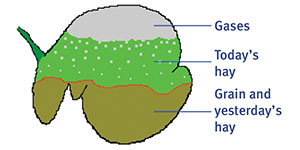
Source: Figure courtesy of R. Bowen.
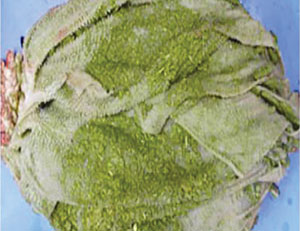

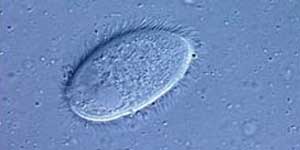
Source: Figure courtesy of R. Bowen.
In addition to fermentation end products, the host animal obtains most of its dietary protein from the digestion of the microbes growing in the rumen. Nonruminant animals cannot utilize microbes to meet their protein requirements because the fermentation process occurs after feeds have passed through the stomach and small intestine. The wall of the rumen is lined with small finger-like structures called papillae (see Fig. 3). These papillae serve to dramatically increase the surface area of the rumen epithelia and thus enhance absorptive capacity.
The rumen contents are generally stratified in three layers (see Fig. 4): a small gas cap, middle fibrous mat layer, and a lower liquid layer. The gas cap consists of 60%-70% carbon dioxide and 20%-30% methane, along with a few other products of fermentation. The fibrous mat layer is composed of long dietary fiber materials that help stimulate rumination.
The bacteria found in the rumen — more than 150 billion per teaspoon — are distributed within the fibrous mat and liquid layers. Type of feed material and bacterial reproductive rate determine which organisms are present at any given time. Bacteria and protozoa that do not reproduce quickly must attach to fibrous material that is digested slowly (longer rumen retention time) if they are to remain in the rumen and not be digested.
The third chamber is the omasum, a basketball-size stomach on the right side of the cow. The omasum is responsible for a great deal of water absorption and for regulating particle passage rate from the rumen. The omasum contains up to 4 gallons of digesta. The omasum is frequently referred to as the manyplies because it contains numerous large parallel epithelial folds or leaves (see Fig. 5).
The abomasum is frequently referred to as the true stomach because it is similar to a human’s stomach in structure and function. The abomasum’s epithelial tissue contains secretory cells that are responsible for producing mucous, pepsinogen and hydrochloric acid (see Fig. 6). Consequently, the environment within the abomasum is very acidic, with a pH of around 2 to 4. Here, digestive enzymes and the strong acids initiate the breakdown of rumen bacteria, complex proteins and starches for digestion in the small intestine. The abomasum holds about 5 gallons, and the digesta moves through it quickly.
Rumination is the process of ingesting feed rapidly and chewing it at a later time. The regurgitated material is called a bolus or cud and consists primarily of chewed material coated with saliva. The rumination process results in the secretion of saliva, up to 45 gallons per day. Saliva neutralizes the acids produced during fermentation and helps to maintain an ideal environment for microbial growth. The process of rumination reduces the particle size of feeds, which enhances microbial function and feed passage.
Microorganisms and the rumen
A marvelous symbiotic relationship exists between rumen bacteria (see Fig. 7) and the cow, allowing consumption of dietary material that would be indigestible to the cow alone. Outside of the feedlot, forages make up the majority of beef cattle diets. Microbial fermentation of forages yields products usable by the host.
Forages provide energy for ruminants through the fermentation of plant carbohydrates. Structural carbohydrates, like cellulose and hemicellulose, require fermentation and yield varying amounts of energy. Nonstructural carbohydrates, like grains, are quickly fermented and provide large amounts of energy.
Immature, high-quality forages are rapidly and thoroughly digested, resulting in high levels of forage and total energy intake. As forages mature, the fiber (lignin) content increases, making the remaining plant carbohydrates less available and slower to digest by the bacteria. This causes forage intake and total energy intake to decline.
The rumen provides a site where microorganisms can digest carbohydrates, proteins and fiber. More than 150 different species of microorganisms have been identified in the rumen. They include bacteria (the most abundant), protozoa, fungi and viruses. The general groups of bacteria are fiber-fermenting (pH 6), general purpose (pH 5 and 6), starch- and sugar-fermenting (pH 5), and methane-producing (pH 6).
There are two basic groups of bacteria which function at various pHs. The fiber digesters are most active at a pH of 6.2 to 6.8. The starch digesters prefer a more acidic environment, a pH of 5.2 to 6.0. Normal feeding practices should maintain a pH range between 5.8 and 6.4.
Carbohydrates, both structural and nonstructural, undergo microbial fermentation and produce volatile fatty acids (VFAs). The primary VFAs are acetic, propionic and butyric acids. The VFAs can provide up to 80% of the energy needs of the animal.
Acetic acid can constitute up to 60% of the total VFAs produced when cattle consume forage diets. Propionic acid production increases substantially and can be as high as 20% of the total VFAs when cattle consume concentrate (high-grain) diets. Butyric acid provides energy to the rumen wall and makes up 12%-18% of the total VFAs. Despite wide swings in the microbial population, ruminal VFA proportions are fairly stable among diets. The rumen papillae are largely responsible for absorption of the VFAs.
Beef cows derive the majority of their protein from digestion of rumen bacteria that contain approximately 60% protein, which is of high quality and digestibility. The remaining supply of amino acids is from dietary protein, which escapes digestion in the rumen. Amino acids are absorbed in the small intestine and are used to synthesize muscle, milk and other proteins used in bodily functions.
For bacteria to maintain an adequate population in the rumen, they must attach to rumen digesta or feed particles. Since the passage rate of the mat layer is slower than the liquid phase, slower-growing species attach to fibrous feeds and are prevented from being washed out of the rumen.
Consideration of microbial population is essential when making dietary changes. A transition period to allow shifts to different microbial species is needed. This adaptation may take several days. One of the most common problems encountered in nutritional management is the sudden change in the ruminant’s diet to include large amounts of readily fermentable carbohydrates (grains). This rapid change will result in a succession of changes in the rumen microbial population and high acid production that results in acidosis.
Conclusion
For efficient beef cattle nutrition, cattlemen must meet the dietary needs of both the cow and the rumen microorganisms. This requires a combination of scientific knowledge, creativity and management skills. Feeding programs should maximize microbial protein production first and then meet additional nutrient requirements over and above those not met by microbial fermentation end products.
References
Bowen, R.A., L. Austgen, and M. Rouge (2000) Pathophysiology of the Digestive system.
http://arbl.cvmbs.colostate.edu/hbooks/pathphys/digestion/index.html
NRC. (2000) Nutrient Requirements of Beef Cattle (7th Edition). National Academy Press, Washington, D.C.
Van Soest, P.J. (1982) Nutritional Ecology of the Ruminant. Comstock Publishing Associates.
[Click here to go to the top of the page.]
Western Region
Let’s focus this month on the development and marketing of bulls. In most purebred cattle operations, income from the sale of bulls represents the largest percentage of their annual income. Therefore, determining how to maximize net profit from this group of animals is extremely important in terms of influencing the financial success of the operation.
Marketing ability is extremely important, and it is one area that most purebred producers struggle with for many years as they get started in the business. Most bulls are marketed to commercial cow-calf producers, and it takes an extended period of time to establish the relationships and customer base to become a successful marketer of bulls. In my opinion, the keys to developing a strong customer base for bulls include:
- First and foremost, have a good product to sell;
- Represent the bulls with honesty and integrity; and
- Stand behind them fully.
The old advice of not selling something that you would not want to buy is as true today as it ever has been. In addition, word of mouth is still the best advertising in the world when it comes to commercial bulls. All one has to do is not stand behind a bull that goes bad for whatever reason. Once that word gets spread around to commercial producers, you will be able to appreciate the value of word-of-mouth-advertising and the value of a good reputation.
Many of those commercial producers are probably not on Facebook or other forms of social media, but I will guarantee you that “coffee shop talk” is faster than the Internet when it comes to not standing behind a bull. Many times on a short-term basis it can present a pretty significant financial loss. However, in my opinion, on a long-term basis it will pay dividends.
Although feed costs have declined significantly compared to the high costs that we faced a few years ago, the higher feed costs that we have experienced for the last five years or so have had a dramatic influence on the cost of developing both bulls and heifers.
Some producers can develop their calves out on pasture by providing supplemental nutrition to achieve the desired level of performance. This is a tremendous advantage, especially in periods of high feed prices. This practice is more commonly used for heifers as compared to bulls; however, it can be used successfully for both sexes. Most purebred beef producers don’t have these kinds of pasture situations available and therefore must confine their calves to a drylot for developmental purposes.
For many years, the costs of developing bulls ranged from $2 to $2.50 per head per day, depending on the location and type of feeding operation. However, since the ethanol fiasco drove corn prices through the roof, many producers have faced developmental costs of $3 to $4 per head per day or higher.
In my opinion, it is extremely important that producers avoid two things when developing bulls. First, we have to avoid feeding below-average bulls. However, the demand for Angus bulls has been so strong during the last 10 years that many Angus producers in our state have never castrated a bull calf. It is still important that purebred producers look at their bull calves with a critical eye and a sharp knife.
The second point is to minimize the length of the developmental period if that is an option. If we could convince commercial cow-calf producers to buy bull calves at weaning, I believe it would be a win-win situation for both purebred and commercial producers. Purebred producers would sacrifice yearling measurements. However, a $2,000-$2,500 weaned bull calf will probably net more dollars than a $4,000-$5,000 long yearling. In addition, bulls would be gone long before they cause many of the problems for which they are known, and commercial producers would be able to acclimate the bulls to their own environment and develop them to fit their own needs.
Many times bulls are developed on “hotter” or higher-energy diets or rations than what is optimal to get the impressive yearling weights that will add value to those bulls. The extra fat that comes with this higher rate of development hurts feet and leg soundness, and also hurts reproductive soundness as fat is deposited in the scrotum and around the reproductive tract of the bull. In addition, many times these “fat” bulls have a hard time acclimating to “rougher” types of range situations once they are turned out. The problem is that commercial producers will say that they do not want to buy “fat” bulls, but at the same time they will go to a sale and buy the big, stout, heavy bulls that many times are just fatter than the bulls that they passed by.
In summary, I would strongly encourage purebred producers to get a handle on all the costs that are going into the development and marketing of their bulls. Then, with those costs in front of them, sit down and develop a strategy to maximize net profit from this group of animals that represents a major source of income in many purebred cattle operations.
[Click here to go to the top of the page.]
Midwest Region
Improving margins with better grazing management
The latest USDA projections indicate current feeder prices may be representative of the next 10 years. Unlike the cattle market, annual cow costs are not likely to collapse and are projected to remain in excess of $800 per year. Therefore, because we cannot dictate cattle prices, the onus is on the producer to identify areas to control input costs without sacrificing the productivity of the herd. In most beef operations, regardless of size, the single largest cost is feed.
Typically, feed represents 50%-60% of total costs in the cow-calf sector, and the large proportion of these costs in the Midwest can typically be attributed to harvest feeds and forages. Logically, this would suggest that controlling harvested feed costs offers the opportunity to improve margins in the cow-calf sector. Perhaps the most efficient way to control winter feed costs is through proper planning and implementation of an extended grazing system. It’s never too early to prepare your grazing plan for 2017.
During the last 20 years, multiple beef cow business record analyses have noted the most profitable beef herds are the ones that utilize some sort of extended grazing system. Whether it is through the use of stockpiled grasses, cornstalk grazing or a combination thereof, more grazing equals more profit. Understandably, the more forage that the cow can harvest for herself, the less we have to deliver to her. Thus, increasing grazing days decreases feed costs and reduces fuel use, wear and tear on equipment, and labor used to deliver it.
Before you start extending your grazing season, it’s imperative to know where you are starting from to have the chance to monitor progress. Do you know how many grazing days you had this year, how much supplemental feed you delivered, and how many tons of harvested forages were fed? How many cows do you have this year? Are you maintaining the herd, expanding or reducing herd size as you move forward? Unfortunately, many producers find it challenging to give concrete answers to these questions due to less-than-ideal recordkeeping.
Another key component that should be considered is the array of forage species to which you have access. Tall fescue is the most commonly stockpiled forage that producers use, but a variety of cool-season grasses make acceptable stockpiled forages. The one area of contention, even among many grazing experts, is the best approach to stockpiling forages.
Some producers graze or hay pastures in the early- to mid-summer period and then allow it to grow until the first killing frost. Other producers who have increased pasture availability may leave pasture ungrazed the entire summer and graze it only in the fall and winter.
The first option results in higher-quality grass that is less mature at the time of winter grazing, but will obviously reduce tonnage available. With this strategy, less supplement may be needed while grazing due to the higher-quality forage. On the other hand, leaving the stockpile pasture undisturbed all summer will significantly increase the amount of forage available, but quality will be lower. This may be of concern if you plan to use fall-calving cows to graze the stockpiles, as they will likely need some sort of supplementation to meet nutritional requirements for lactation.
Grazing strategy is the other major consideration that should be made to maximize fall and winter forages. The low-input option is to turn cows out and let them graze the entire acreage. Unfortunately, only about 50% of the forage will be effectively grazed, with the remainder being wasted and trampled. Because the forage is no longer growing, rotational grazing is not a viable option either.
The best use of the existing forage is to strip-graze it. In other words, fence off a strip of new forage every day or every few days to give the cows what they need to meet their requirements. With this method, some producers have found that as much as 85% of the stockpile is consumed. While it may increase labor, the return on investment is typically quite good, particularly for producers who have a limited land base and need to make every acre of forage “count.”
One point of order: Don’t be scared of the snow! Cows can graze in snow up to 18 inches deep (although many producers don’t like to push the limit that far). If snow is an issue, some of the more progressive graziers I know will push a strip of snow off of the grass with a tractor blade, similar in concept to a strip-grazing system, until the snow melts. Admittedly, this may be more problematic for producers further north where the snow does not melt once winter fully sets in.
The other forage that fits well in a winter-grazing program is cornstalks. In the Midwest, most of us don’t have to look too far out the window to find a corn field, and thus availability of forage is typically not limiting. What may be limiting is a legal perimeter fence and a reliable water source. While a single strand of hot wire may keep cattle in, this fence likely will not protect you in the event that cows would get out and cause damage to property or a vehicle. Check your local state laws for what constitutes a legal fence.
The typical rule of thumb is that approximately 16 lb. of leaf and husk exist for every 1 bu. of corn harvested per acre. For example, if the field made 150 bu. per acre, then there should be about 2,400 lb. of leaf and husk per acre. We concentrate on the leaf and husk because this is the most palatable and digestible fraction of the residue. Once cows have sought out and consumed any grain left in the field, the leaf and husk is what they will eat next.
Keeping this in mind, it is not suggested to graze cornfields that have had significant wind damage prior to harvest. The ear drop that may have occurred could lead to acidosis, founder or even death in cattle when too much corn is consumed too quickly.
It may be assumed that a cow will eat approximately 2.5% of her body weight in cornstalks per day. Thus, if she weighs 1,300 lb., she will consume about 32.5 lb. of cornstalks per day. Combine this with the leaf and husk estimate to determine how many days you can graze a given size group of cows. Again, be conservative and assume cows will only graze 50% of the leaf and husk. The other half will likely be trampled or deteriorate over time. If you are limited in your access to stalks, strip-grazing may be an effective use of this forage.
If you have not made a change in your grazing plan for this year and do not have access to stockpiled forage or stalks, there are still a few things you can do this winter to prepare for an improved grazing season this year. First, assess the number of forage species in your pasture. If legumes are limited, consider frost-seeding red clover when the freeze-thaw cycles begin. Typically, 3-5 lb. of red clover seed per acre should be broadcast every two or three years. The clover will help with nitrogen fixing for the surrounding grasses, and will also provide some extra tonnage and energy during the summer months, when cool-season grasses slow their growth.
As always, for questions regarding forage management, consult with the team of experts you have assembled, including your nutritionist, beef extension specialist and herd health veterinarian.
[Click here to go to the top of the page.]







